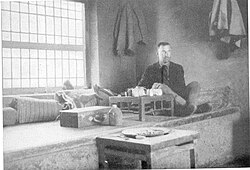Kangbed-stove

Thekang(Chinese:Kháng;pinyin:kàng;Manchu:![]() nahan,Kazakh:кән) is a traditional heated platform, 2 metres or more long, used for general living, working, entertaining and sleeping in the northern part ofChina,where the winter climate is cold. It is made ofbricksor other forms of firedclayand more recently of concrete in some locations. The wordkangmeans "to dry".
nahan,Kazakh:кән) is a traditional heated platform, 2 metres or more long, used for general living, working, entertaining and sleeping in the northern part ofChina,where the winter climate is cold. It is made ofbricksor other forms of firedclayand more recently of concrete in some locations. The wordkangmeans "to dry".
Its interior cavity, leading to an often-convolutedfluesystem, channels the hotexhaustfrom afirewood/coalfireplace,usually thecooking firefrom an adjacent room that serves as a kitchen, sometimes from a stove set below floor level. This allows a longer contact time between the exhaust (which still contains much heat from the combustion source) and (indirectly) the inside of the room, hence more heat transfer/recycling back into the room, effectively making it aducted heatingsystem similar to the Romanhypocaust.A separate stove may be used to control the amount of smoke circulating through thekang,maintaining comfort in warmer weather. Typically, akangoccupies one-third to one half of the floor space, and is used for sleeping at night and for other activities during the day.[1]Akangwhich covers the entire floor is called adikang(Chinese:Địa kháng;pinyin:dì kàng;lit.'groundkang').[1]

Like theEuropeanmasonry stove,a massive block ofmasonryis used to retain heat. While it might take several hours of heating to reach the desiredsurface temperature,a properly designed bed raised to sufficient temperature should remain warm throughout the night without the need to maintain afire.
History[edit]
Thekangis said[by whom?]to be derived from the heated bed floor called ahuoqiangfound inNeolithicChina, according to archeological excavations of building remains in Banpo Xi'an. Sites inShenyang,Liaoning, show humans using the heated bed floor as early as 7,200 years ago.[2][3]The bed at this excavation is made of 10 cm pounded clay on the floor. The bed was heated byzhidi,placing an openfireon the bed floor and clearing the ashes before sleeping. In the excavated example the repeated burning is believed to have turned the bed surface hard andmoistureresistant.
The first known heated platform appeared in what is now Northeastern China and used a single-fluesystem like theRomanhypocaustand the Koreanondol.[3]An example was unearthed among 1st-century building remains inHeilongjiang Province.Its flue is L-shaped, built from adobe and cobblestones and covered with stone slabs.
Heated walls with a double-flue system were found in a 4th-century palace building inJilin Province.It had an L-shapedadobebench with a double-flue system. The structure is more complex than a single-flue system and has functionality similar to akang.
Literary evidence fromLi Daoyuan'sCommentary on the Water Classicalso gives evidence of heated floors during theNorthern Wei Dynasty(386–534 AD), though this was not explicitly named adikang:[1]
In Guanji Temple [near the present-dayFengruninHebei province], there is a grand lecture hall. It is very high and wide to accommodate a thousand monks. The platform of the hall was constructed with stones arranged as a network of channels, and the floor was finished with a coat of clay. Fires are set at outdoor openings at the four sides of the platform, while the heat flows inwards, warming the entire hall. The construction was established by a benefactor (or benefactors) to enable the monks to study in cold winters.
Thekangmay have evolved to its bed design due to ongoing cultural changes during theNorthern and Southern Dynasties,as high furniture and chairs came to be prevalent over the earlier style of floor-sitting and low-lying furniture in Chinese culture.[1]The earliestkangremains have been discovered atNinghai,Heilongjiang Province, in the Longquanfu Palace (699–926) ofBalhaeorigin.
Culture[edit]

Traditional Chinese Dwellings(Zhongguo chuantong minju) (a bilingual text) has a few line drawings ofkangs.It says that thekangis used to cook meals and heat the room, making full use of the heat-retaining capacity of theloess(soil used to makeadobe). Thekangproduces radiant heat to indirectly warm the interior space as well as the bed mass itself. It has been speculated that one of the oldest forms of Chinese housing, heated cave dwellings known asyaodong,widespread throughout northern China would have been uninhabitable without thekang.[1]
Thekangwas also an important feature of traditional dwellings in often-frigidManchuria,where it was known asnahaninManchu.It plays an important role in Manchurianmourningcustoms. The deceased is placed beside thekanginstead of in the central hall, as isHan Chinesepractice. The height of the board on which thebodyis placed indicates the family status or age of thedeceased.[citation needed]
See also[edit]
- Hypocaust
- Kotatsu
- Masonry heater
- Ondol– similar system in Korea
- Russian stove
- Underfloor heating
Notes[edit]
- ^abcdeGuo, Qinghua (2002). "The Chinese Domestic Architectural Heating System [Kang]: Origins, Applications and Techniques".Architectural History.45.SAHGB Publications Limited: 32–48.doi:10.2307/1568775.JSTOR1568775.
- ^BeanOlesenKim (2010).
- ^abZhuang, Zhi; Li, Yuguo; Chen, Bin; Jiye; Guo (2009), "Chinese kang as a domestic heating system in rural northern China—A review",Energy and Buildings,41(1): 111–119,doi:10.1016/j.enbuild.2008.07.013
References[edit]
- Bean, Robert; Olesen, Bjarne W.; Kim, Kwang Woo (January 2010),"History of Radiant Heating and Cooling Systems"(PDF),ASHRAE Journal
- Bernan, Walter (1845),On the History and Art of Warming and Ventilating Rooms and Buildings by Open Fires, Hypocausts... Stoves... and Other Methods; with notices of the progress of personal and fireside comfort, and of the management of fuel,Walter Bernan is a pen-name for Robert Stuart Meikleham, London: George Bell
- Guo, Qinghua (2001). in Chan, Alan; Clancey, Gregory; Loy, Hui-Chieh (eds.).Historical Perspectives on East Asian Science, Technology and Medicine.Singapore: World Scientific. pp. 505–514.ISBN9789971692599.Proceedings of the 9th International Conference on the History of Science in East Asia, held August 23–27, 1999 in Singapore.
